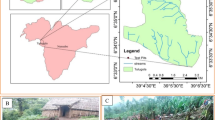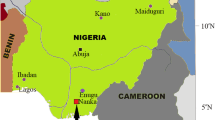Abstract
This work describes the results of the geotechnical and hydrogeological characterization of a very slow landslide involving Acero, a village in the Northern Apennine. Through boreholes and geophysical surveys, it was possible to obtain a geological profile of the landslide, while through some monitoring activities we were able to obtain information about displacements and water table. Laboratory tests completed the definition of the geotechnical and mineralogical properties of the soil. The landslide shows maximum speed values of 1.5 cm/y, with maximum accelerations during heavy rain periods. This landslide has been classified as a residual state type and can be considered as dormant or active, depending on vertical effective stress and pore pressure variations. The hydrogeological risk mitigation is carried out through the interpretation of the landslide trigger and evolution mechanisms such as the reduction of the water table level.
Access provided by Autonomous University of Puebla. Download conference paper PDF
Similar content being viewed by others
Keywords
1 Introduction
Landslide hazard in Italy is very high, representing one of the main issues in natural hazard control. Among natural causal factors, we can recognize the ground conditions (lithological and structural features), the geomorphological processes (tectonic uplift and fluvial erosion of the slope toe) and physical processes (heavy and short rainfalls and continuous high precipitation). Nevertheless, landslide hazard is also related to man-made processes, especially to the insufficient maintenance of the drainage systems and the vegetation removal.
Climatic changes accelerate landslide frequency and size, and this often causes high expenses and human losses (ISPRA 2008). Recently, a policy based on risk prediction and prevention has been adopted in Italy, and now there is more interest about the understanding of the landslides causal factors and their mitigation.
A detailed knowledge of landslide failure mechanisms becomes a main aspect for the identification of the landslide causal factors.
The aim of this study is to obtain a geotechnical and hydrogeological model of the Acero landslide for the landslide risk mitigation. Acero is an agricultural village at 800 m a.s.l., situated in the territory of Borzonasca council (Province of Genoa), near the watershed dividing Po river basin from the Tyrrhenian sea (Fig. 181.1). It’s a typical case of a village built on a very slow velocity landslide; a very frequent situation in the Ligurian Appennine, where landslides often mean cultivable, water-rich level land (Faccini et al. 2013). Both the IFFI (Inventory of Italian landslide phenomenon) mapping project and the Entella River basin master plan specifically mention it as a very high geomorphological hazard area.
Mitigation of geomorphological risk in this area has been representing a priority for public administration policies: indeed, in 1998 Borzonasca council invested substantial resources on a hydrogeological preliminary project and then, in 2009, Liguria Region spent a first lot of 500,000 euros to study and settle the landslide through drills and monitoring activities.
2 Method
Study activities started from bibliographic sources: scientific papers, technical maps, basin master planning maps, IFFI and historical maps were examined; especially, comparisons between actual and XIX century maps of the area helped to get an idea of morphological changes in the last 200 years.
A drilling survey—including six boreholes equipped with three inclinometers (BH1 ÷ BH3) and three piezometer cases (P1 ÷ P3)—has been carried out (Fig. 181.2). Several rock and soil samples were collected for geotechnical laboratory tests.
Surveys location map (a): BH1 ÷ 3 Inclinometer with mean displacement vector (BH1 = 0.7 cm/y, BH2 = 0.8 cm/y, BH3 = 1.5 cm/y); P1 ÷ 3 Piezometer; Nk1-3 environmental noise measurement; St1-2 seismic refraction line. The grey buildings show significant damages. Simplified geological cross section between Case Cima d’Acero and Acero villages (b): 1 Sliding surfaces; 2 Mean water table
An original geological and geomorphological survey of the area and a recognition of damaged buildings of Acero were made.
The monitoring activities, performed through inclinometric (every 3 months) and piezometric measurements (monthly for P2 and P3, daily for P1), started in September 2010 and are actually still ongoing; once the main sliding surface has been identified, soil samples in the logged cores will be extracted for further geotechnical and mineralogical tests.
The core data were related by a geophysical survey consisting of n. 2 P-waves refraction lines, n.1 S-waves refraction line, and n. 4 environmental noise measurements interpreted with Nakamura’s technique (Nakamura 1989).
Therefore, the definition of the geological and geotechnical model of Acero landslide has been defined through an interpretative geological section (Fig. 181.2) and slope stability back-analysis, in order to evaluate the mobilized shear strength referred to the slip surface.
3 Results and Discussion
The obtained results have been used to describe the geological and geotechnical details of the Acero landslide: the investigated area is about 0.123 km2, and is characterized by heterogeneous rock masses (Fig. 181.1); the “Canale” formation—made up of limestones, marls and shales, locally including ophiolithic holystostromes—thrusting on the “Scisti Zonati”, composed of siltstones, marls and shales (APAT 2006).
It’s possible to calculate the landslide volume, here approximately 2 ÷ 4 × 106 m3.
Results, coming from the geophysical survey, highlight a first shallow layer, with bottom depth ranging from 4 to 8 m (P-wave velocity 200–1,000 m/s). An intermediate level with thickness ranging from 6 to 20 m was found (P-wave velocity 800–2,200 m/s). A further layer, with a depth from 18 to 22 m below ground level may be related to the bedrock (P-wave velocity >2,200 m/s). The seismic survey data seems to be in agreement with environmental noise measurements and suggest a depth of the bedrock ranging from 16 to 34 m.
The main failure surface has been recognized at different depths (21 m for BH3, 18 m for BH2 and 32 m for BH1), and the monitoring activities allow to evaluate landslide’s average velocity of 1 cm/year (Fig. 181.3). Despite being a very slow movement (Glastonbury and Fell 2008) it locally caused stability problems and structural damages to buildings and roads.
The landslide movement is not continuous and it’s active mostly during periods of heavy rain, when the water table, rising, increases pore pressure values and produces effective shear strength reductions. Indeed, inside the slope there is a permanent aquifer, which has a level ranging from 3.6 to 10.6 m below ground level, related to rainfalls and occasionally snowfalls (Fig. 181.4).
Acero landslide has been classified as a complex type; a rotational sliding evolving in a flow component at the toe. The landslide trigger is due to a residual strength failure mechanism: indeed, its activity ranges from dormant to active, related to vertical effective stress and pore-water pressure variations.
The mobilized shear strength on slip surface evaluated by back analysis, using limit equilibrium method with Slide 6.0 code (Rocscience Inc.), ranges from 24°–25°. The landslide geomaterial is characterized by clayey sand (SC), silty sand (SM) and low-plasticity clay (CL); fine soils show low values of liquid limit (30–40 %), and plasticity index values of 10–15 % (Fig. 181.5).
Bedrock shows fair surface conditions of discontinuities (GSI = 30 − 35, Marinos and Hoek 2001); the shear strength of intact rock material by point load tests index ranges from 0.14 to 2.06 MPa, while its unit weight ranges from 25.5 kN/m3 and 26.5 kN/m3, and sonic waves velocities are about 1,300 m/s.
Through mineralogical analysis carried out on the clay fraction of some soil samples—taken on the sliding surface—it has been possible to identify chlorite and illite, according to the lithology and the index properties of soil (Fig. 181.5). Furthermore, correlating shear strength to mineralogy and index properties, it has been possible to define a satisfying connection with the back analysis results (Lupini et al. 1981).
4 Conclusions
All the surveys carried out in this study have allowed to obtain a geological model of the landslide, and the monitoring results have permitted the evaluation of the landslide dynamics which is related to the water table level.
Taking in consideration the results of this monitoring activity and considering the low cost of the continuous measuring tool installed, it’s believed that the use of this instrumentation could be crucial for a suitable risk mitigation analysis.
The hydrogeological risk reduction can be obtained through the interpretation of the landslide triggering factors and evolution mechanisms: in this case a relevant importance is given to the pore pressure reduction, with the aim of preventing the piezometric head to exceed a threshold level, calculated in 5–6 m of depth at BH1. Finally, it’s necessary to restore the original hydrographic network: the comparison of historical and actual maps highlighted the disappearance of many streams along the landslide in the last 70–80 years, likely causing an increase of the geomorphological hazard.
References
Agenzia per la Protezione dell’Ambiente e dei Servizi Tecnici APAT (2006) Carta geologica d’Italia alla scala 1:50.000 Foglio 214 Bargagli (a cura di P. Elter, M. Marroni, L. Pandolfi). Lac Firenze
Faccini F, Robbiano A, Roccati A, Raso E (2013) Gravity-driven deep-reaching deformations and large-scale landslides in recently uplifted mountain areas: the case-study of Mt. Cucco and Belpiano (Ligurian Apennine, Italy). Ital J Eng Geology Environ (6):141–152
Glastonbury J, Fell R (2008) Geotechnical characteristics of large slow, very slow, and extremely slow landslides. Can Geotech J 45(7):984–1005
Istituto Superiore per la Protezione e la Ricerca Ambientale ISPRA (2008) Landslides in Italy, special report 2008 (a cura di A. Trigila, C. Iadanza). Csr, Roma
Lupini JF, Skinner AE, Vaughan PR (1981) The drained residual strength of cohesive soils. Geotechnique 31(2):181–213
Marinos PG, Hoek E (2001) Estimating the geotechnical properties of heterogeneous rock masses such as Flysch. Bull Eng Geol Environ 60:85–92
Nakamura Y (1989) A method for dynamic characteristics estimation of subsurface using microtremor on the ground surface. Q Rep RTRI 30:25–33
Author information
Authors and Affiliations
Corresponding author
Editor information
Editors and Affiliations
Rights and permissions
Copyright information
© 2015 Springer International Publishing Switzerland
About this paper
Cite this paper
Faccini, F., Lazzeri, R., Robbiano, A. (2015). Engineering Geological and Hydrogeological Characterization of Acero Landslide (Upper Sturla Valley, Northern Apennine). In: Lollino, G., et al. Engineering Geology for Society and Territory - Volume 2. Springer, Cham. https://doi.org/10.1007/978-3-319-09057-3_181
Download citation
DOI: https://doi.org/10.1007/978-3-319-09057-3_181
Published:
Publisher Name: Springer, Cham
Print ISBN: 978-3-319-09056-6
Online ISBN: 978-3-319-09057-3
eBook Packages: Earth and Environmental ScienceEarth and Environmental Science (R0)









